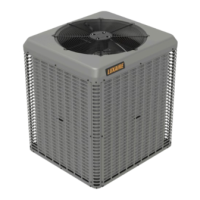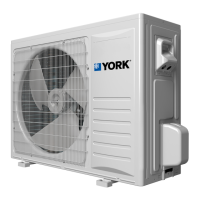Table 67: Faults
Description STATUS LED
W and O signal received at
the same time
11 Flashes
Y2 signal received without
a Y
12 Flashes
Demand defrost
The control maintains proper airflow through the outdoor
coil during heating operation by melting frost and ice that
may form on the coil. Frost may accumulate unevenly in
different sections of the coil because of the arrangement
of the refrigeration circuit within the coil. The control
may initiate a defrost cycle even when the coil is not
completely covered with frost. This is normal operation.
The control regulates the defrost operation of the heat
pump based on accumulated compressor runtime,
outdoor coil temperature, and outdoor ambient
temperature. The control causes the heat pump unit to
operate in the normal heating mode until it determines
that a defrost cycle is needed.
Operation
The defrost mode is equivalent to the cooling mode
except that the outdoor fan motor is de-energized and
the Wout terminal is energized. The control must do the
following to initiate a defrost cycle:
• Energize high indoor airflow through the Y2 out
terminal.
• Energize high compressor speed through the M2
terminal (if not already in second stage).
• De-energize the outdoor fan.
• Energize the reversing valve.
• Energize the auxiliary heat output through the Wout
terminal.
• Begin the maximum defrost cycle length timer.
If the call for heating (Y) is removed from the control
during the defrost cycle, it terminates the defrost cycle
and de-energize the compressor. The control also stops
the defrost cycle length timer but does not reset it. When
the control receives another call for heating, it restarts
the defrost cycle and the timer at the point at which the
call for heating was removed. This happens only if the coil
sensor temperature conditions allow defrost to occur.
Defrost curves
The control uses a set of defrost curve parameters that
are selected using the defrost curve selection jumper. The
location of the defrost curve selection jumper is shown
in the Tabular Data Sheet or Table for each heat pump
model.
Defrost curve selection
The second page of the Tabular Data Sheet or Table 68
indicates the correct jumper setting for the specific heat
pump model.
The control only reads the jumper input when the Y and W
thermostat inputs are de-energized. If a jumper position
is changed while either of these inputs is energized, the
control does not act upon the jumper changes until the
thermostat calls are de-energized or power (24 VAC) to
the control is cycled.
Table 68: Defrost jumper pin settings
Outdoor
unit
18 24 30 36 42 48 60
Defrost
jumper
pin
setting
2 2 2 2 2 2 3
Defrost cycle initiation
The control allows the heat pump to operate in the
heating mode until the combination of outdoor ambient
and outdoor coil temperatures indicate that a defrost
cycle is necessary.
The control initiates a defrost cycle when the coil
temperature is below the initiate point for the measured
ambient temperature continuously for 4 1/2 min. See
Figure 22. This delay eliminates unnecessary defrost
cycles caused by refrigeration surges such as those that
occur at the start of a heating cycle.
The control initiates a defrost cycle every 6 h
(accumulated compressor runtime) to recirculate
refrigerant lubricants. This forced defrost timer resets
and restarts following the completion or termination of a
defrost cycle.
The control initiates a defrost cycle when the Defrost
Inhibit Time Limit elapses if the previous defrost cycle was
terminated based on the Maximum Defrost Cycle Time.
This occurs regardless of the liquid line (coil) temperature
reading. The coil does not have to be cold for the unit to
be forced into defrost. When the defrost cycle begins, the
control follows the normal defrost cycle routine.
The control also initiates a defrost cycle when the TEST
terminals are shorted. This feature allows an installer or
service technician to start a defrost cycle immediately as
required. When the TEST terminals are shorted for more
than 5 s with a Y input energized and the pressure switch
input is closed, the ASCD is bypassed, the reversing valve
is energized, the ODF is de-energized, and the compressor
and the Wout terminal to auxiliary heat are energized.
When the TEST inputs are used to force a defrost cycle,
the control ignores the state of the coil temperature and
outdoor ambient temperature inputs. The coil does not
have to be cold and the outdoor temperature does not
have to be within a certain range for the heat pump to be
forced into a defrost cycle. After the TEST input jumper
is removed, the defrost mode terminates as normal. The
defrost cycle length timer does not start until the TEST
input is removed. If the TEST terminals remain shorted,
the control keeps the unit in defrost mode.
Defrost inhibition
The control does not initiate a defrost cycle if the liquid
line temperature is above 32°F (40°F for curve 4), unless
the defrost cycle is forced using the TEST input, or the
previous defrost exited on the maximum time of 14 min.
The control also prevents a defrost cycle from being
initiated too soon after the initiation of the previous
defrost cycle. When power is applied to the control and
after the completion or termination of each defrost cycle,
Installation Manual: R-410A Outdoor Split-System Heat Pump - YH2F, THF2, RHP150 Series 39
Johnson Controls Ducted Systems

